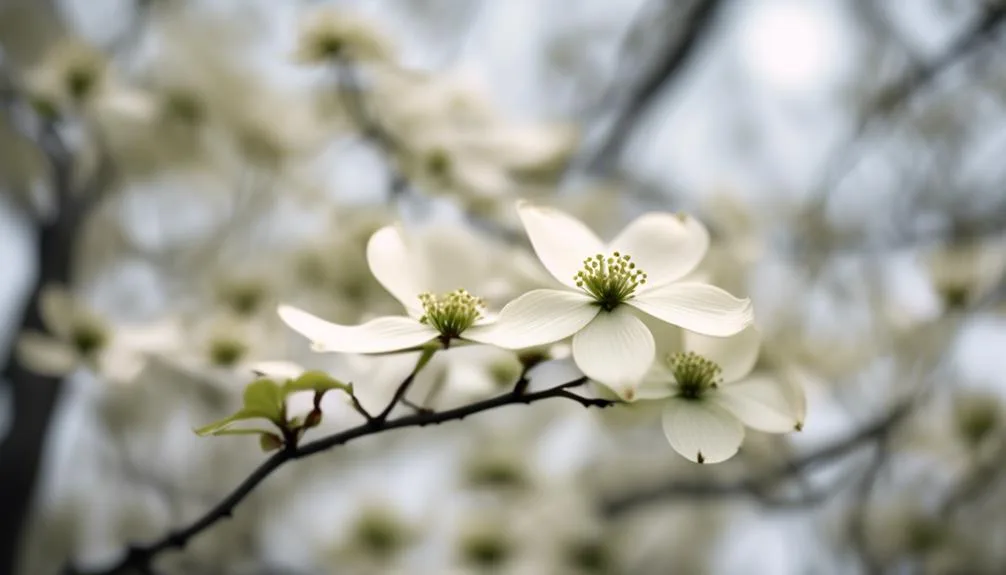Dogwood trees, known for their delicate beauty, can struggle when faced with strong winds. Gardeners and nature enthusiasts often wonder about the effects of high winds on these trees.
Understanding how they respond to such forces is vital for their care. Let's explore the potential impact of high winds on dogwood trees and how to protect them from damage.
Dogwood Tree Characteristics
With their delicate white flowers and distinctive branching patterns, dogwood trees add an elegant touch to any landscape. This tree species, known for its beauty, belongs to the Cornus genus and comes in various types, such as the flowering dogwood and the kousa dogwood.
Dogwood trees thrive in well-drained, moist, and acidic soil with a pH range of 5.5 to 6.0. They also prefer soils rich in organic matter and benefit from mulching to maintain soil moisture.
Additionally, these trees require a site with partial shade to full sun for optimal growth. Understanding the soil requirements is crucial for successfully cultivating dogwood trees and ensuring their health and longevity.
Impact of High Winds on Dogwood Trees
In high winds, dogwood trees may experience damage to their delicate branches and flowers, impacting their overall aesthetic appeal and structural integrity. Dogwood trees, known for their stunning blossoms, have moderate wind resistance. However, during severe weather patterns such as strong gusts or storms, their vulnerability increases. The combination of their broad, horizontal branching pattern and relatively shallow root systems makes them susceptible to wind damage. The impact of high winds on dogwood trees can result in broken or split branches, dislodged flowers, and even uprooting in extreme cases. To better understand the potential effects, consider the table below detailing the wind resistance of different tree species, including dogwood, and how weather patterns contribute to their vulnerability.
| Tree Species | Wind Resistance | Weather Patterns |
|---|---|---|
| Dogwood | Moderate | Severe gusts, storms |
| Oak | High | Resilient to most winds |
| Pine | Low | Susceptible to gusts |
Signs of Wind Damage on Dogwood Trees
If you notice any of the following signs on your dogwood tree, it may indicate wind damage: broken branches, torn or dislodged flowers, or a leaning or uprooted tree. Witnessing these distressing signs can be disheartening, especially if your dogwood tree holds sentimental value.
Here are some emotional responses you might experience:
- *Frustration and Concern*:
- Feeling frustrated seeing the once beautiful blooms torn and scattered by the wind.
- Concern for the health and stability of your beloved dogwood tree.
Ensuring proper tree maintenance, such as regular pruning and inspection, can help improve wind resistance. Additionally, selecting wind-resistant dogwood tree varieties can mitigate the risk of wind damage.
It's essential to remember that while wind can cause damage, with proper care, your dogwood tree can recover and flourish once again.
Preventing Wind Damage to Dogwood Trees
After witnessing the distressing signs of wind damage on your dogwood tree, it's crucial to take proactive measures to prevent future harm and foster its resilience.
Providing tree support is essential in preventing wind damage. Use stakes or guy wires to support young or newly transplanted dogwood trees, helping them establish strong root systems.
Additionally, pruning your dogwood tree to remove weak or damaged branches can improve its wind resistance. Regular pruning also promotes a balanced canopy, reducing the risk of wind damage.
Choosing a sheltered planting location can further protect your dogwood tree from strong winds. Select an area with natural windbreaks, such as other trees or structures, to shield your dogwood from powerful gusts.
Recovery and Care for Wind-Damaged Dogwood Trees
To nurse your wind-damaged dogwood tree back to health, it's essential to assess the extent of the damage and promptly initiate proper care and recovery measures. Begin by removing any broken or damaged branches using clean pruning techniques to promote new growth. Evaluate the soil composition around the tree, ensuring it's well-draining and rich in organic matter to support the recovery process.
Here are some important points to consider:
- Emotional Appeal:
- Seeing your beloved dogwood tree damaged can be distressing, but with proper care, it can thrive again, bringing joy back to your garden.
- Practical Advice:
- Taking the time to assess and care for your tree not only aids its recovery but also fosters a deeper connection with nature.
Conclusion
To safeguard dogwood trees from high winds, it's essential to recognize signs of damage and take preventive measures. Understanding their characteristics and providing proper care can help these beautiful trees thrive and endure.
How will you protect your dogwood trees and ensure their longevity?

My interest in trees started when I first saw the giant sequoias in Yosemite.
I was a teenager then, and I remember thinking, “I need to learn more about this.”
That moment stuck with me.
A few years later, I went on to study forestry at Michigan Tech.
Since graduating, I’ve worked in a mix of hands-on tree care and community education.
I’ve spent over ten years helping people understand how to plant, maintain, and protect the trees in their neighborhoods.
I don’t see trees as just part of the landscape.
They are living things that make a real difference in our daily lives.
